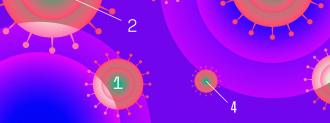Calling the virus that causes COVID-19 the coronavirus is a little misleading — in fact, it is only one of hundreds of coronaviruses.
The majority of these coronaviruses infect only birds or animals, but seven (so far) have made the jump to humans.
Four trigger only mild symptoms in people, but three cause serious diseases — SARS, MERS, and now, COVID-19 — and many virologists believe it’s only a matter of time before the next deadly coronavirus emerges.
“This has already happened three times,” Daniel Hoft, a virologist at Saint Louis University, told the New York Times. “It’s very likely going to happen again.”
Vaccines are one of the best ways to halt the spread of an infectious disease, and the U.S. approved its first COVID-19 vaccines less than a year after the pandemic began — a huge achievement, given that the process usually takes a decade.
Still, hundreds of thousands of Americans died while that shot was being developed, and the virus is already evolving new variants. A better approach, according to infectious disease expert Kayvon Modjarrad, is having a vaccine ready before a pandemic starts.
“Fast — truly fast — is having it there on day one,” he told the NYT.
We can’t develop a vaccine for a specific coronavirus we haven’t seen yet, but we may be able to create a universal coronavirus vaccine, one that can protect against a range of coronaviruses and not just one.
Several groups are now developing such a vaccine — and one just announced its promising progress.
A Universal Coronavirus Vaccine
When the immune system encounters a pathogen for the first time, it creates proteins called antibodies. If it infects the body again, those antibodies can then quickly identify and disable the invader, as well as triggering the broader immune system.
Vaccines protect against disease by producing these antibodies before an infection. Most COVID-19 vaccines do this by introducing the body to one antibody-triggering part of the coronavirus, called its spike protein.
All coronaviruses have spike proteins — the spikes give the viruses a crown-like appearance, which is how they got their name — and they use those proteins to attach to and infect host cells.
To create a universal coronavirus vaccine, researchers at CalTech started with a vaccine framework called a “mosaic nanoparticle,” which looks like a cage made up of 60 identical proteins.
They then engineered fragments of spike proteins from eight coronaviruses — SARS-CoV-2 and the seven that infect animals but are considered a threat to humans — to bind to the nanoparticle’s framework. The end result was a vaccine with lots of different coronavirus spike fragments sticking out of it.
When the universal coronavirus vaccine was injected into mice, it triggered the production of antibodies that reacted to the eight coronaviruses and four others, as well. Three of those were viruses that infect animals and one was a coronavirus that infects humans: SARS-CoV.
This suggests that the vaccine taught the immune system to recognize common characteristics of coronaviruses.
“(This study shows) that it is possible to raise diverse neutralizing antibody responses, even against coronavirus strains that were not represented on the injected nanoparticle,” researcher Pamela Björkman said in a press release.
An Ounce of Prevention…
Triggering the production of antibodies in mice is a good first step toward the development of a universal coronavirus vaccine, but there are many more to come.
First will be determining whether CalTech’s vaccine can actually prevent infections or disease symptoms in animals. If so, human trials could follow.
If those trials are successful and the vaccine is approved, the next time a dangerous coronavirus makes the jump to humans, we might already be protected against it — and preventing a pandemic is far preferable to defeating one.
“None of us wants to go through this again,” Matthew Memoli, a virologist at the NIAID, told the NYT. “And we don’t want our children to go through this again, or our grandchildren, or our descendants 100 years from now.”
We’d love to hear from you! If you have a comment about this article or if you have a tip for a future Freethink story, please email us at [email protected].






